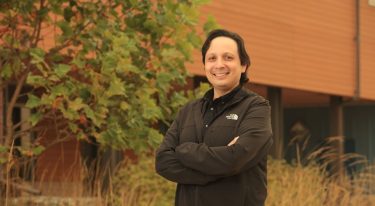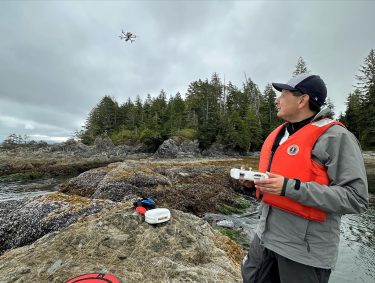Corey Garza begins his tenure as the UW College of the Environment Associate Dean for Diversity, Equity and Inclusion, and as a Professor of Aquatic and Fishery Sciences effective September 1. We sat down with Garza to talk about the vision for his new role, his approach to advancing equity and inclusion, and what he ultimately hopes to achieve.
What appeals to you most about coming to the College of the Environment to lead DEI efforts? What opportunities do you see?

Most of my DEI work has been within the ocean sciences, yet I’ve been interested in how you take those lessons learned about increasing diversity and apply them more broadly across STEM. One of the unique aspects of the College of the Environment is it gives us this opportunity since it represents so many different disciplines across STEM, from atmospheric sciences to ocean sciences and beyond.
It also is a chance to learn about some of the challenges that other disciplines in STEM have relative to increasing diversity. Each discipline has its own specific landscape, and what worked in the ocean sciences might not necessarily work in the geological sciences, for example. Because UW is internationally known, I think it may be an opportunity to take a lot of the lessons learned here and position Washington as a national and international leader in diversifying STEM.
How do you approach advancing DEI broadly while also identifying what’s needed at a specific place like the College of the Environment?
I think developing those personal, one-on-one interactions is very important — that’s been a big part for me. Each discipline or institution has its own set of external factors or specific barriers. Getting to know everyone in each place as best as I can, talking to the technical staff, to the office staff, to students, faculty, deans and provosts to really try to understand different perspectives and barriers, you start to get a more holistic understanding of what the internal challenges are to diversity. I think without building those connections, your diversity programs aren’t going to be as effective as they can be.
What are your initial goals and what are some of the pathways you’re thinking about to help achieve those goals?
Coming in, one of my first goals is to try to unify as best as I can the different DEI efforts already ongoing. I want to get an understanding of what programs are already in place, how can we start to organize so they are in parallel and in concert with each other, so that they’re working together. And while sharing what they have in common is important, we also need to understand where they differ. Atmospheric sciences challenges, for example, will be a little bit different relative to oceanography or forestry because of the unique landscapes that they’re working within.
Part of achieving this goal is visiting the different units in the College of the Environment to try to really understand the different communities, get to know them and have a visible presence there. I want them to know that there’s an office here, there are people working on this and that there’s someone that they can contact. I think if you don’t establish those lines of communication early on, any subsequent programs are bound not to be as effective as they can be.
What differences do you see in terms of DEI support needs between disciplines?
It is highly variable. But, for example, the ocean sciences can sometimes be perceived as less accessible than other sciences. You’re way out at sea, it’s a very remote, inaccessible place, the depictions of what ocean scientists look like can include expensive gear, like scuba, that can appear to be financially exclusive. Whereas doing something like geology might be viewed as a little bit more accessible. Something like a nearby hillside might be perceived as easier to get to and explore.
Another example is in the disability space, where the geosciences can be viewed as inaccessible because they often feature depictions of very physically active people, whether it’s a diver on a boat or the geologists hiking out in the field.

I had a student that had a specific medical condition and the other students were telling them, “Oh, you couldn’t be a marine biologist because you can’t scuba dive.” It was crushing for the student. And then they came into our marine drone program and became a drone pilot. That’s an important part of my group’s research approach: presenting multiple ways of being a scientist. I recall during the height of COVID closures, our drone group was allowed to go out and work because there’s one person, outside, with a drone. That student wound up being one of the few people able to go out to the field to collect data. When you have a stereotype or mindset about what it means to be a researcher or a scientist in a particular discipline, it can be one that’s very exclusive.
What gives you hope and drives you to do this work?
I’ve seen shifts in attitudes around this work. I think a lot of it has to do with the George Floyd murder and the protests of 2020, but I’m starting to see people a bit more open about it. Some of the funding agencies are starting to put significant resources behind their long-term DEI and broadening participation programs. I’m seeing people be a bit more intentional when thinking about this. People are asking how they can be better informed and educate themselves about these topics.
When I go to conferences, DEI sessions are more prominent. I have a group of colleagues that I work with, and we’d always joke that our session was either always at 8:00 AM at some point during the conference or the afternoon session on the last day of the conference. Now, we’re starting to see these sessions at times where their visibility is increased. And there are a lot more of them now, so that’s starting to give me a little bit of hope. I’m also seeing generation differences in how the next generation of scientists think about DEI issues. When I was in graduate school, other graduate students didn’t talk about DEI issues because there was a perception that it would distract from your research, and then could interfere with your tenure track line. Now, I see graduate students, postdocs, early career faculty and early career scientists starting to think about this.
I grew up in East LA, in a Mexican-American family where I was the first person who went to college, and I benefited a lot from programs that looked to engage students who weren’t historically in STEM. My own career path started in a high school STEM program at the LA County Natural History Museum. That was my transformative event, the first time I saw myself doing something other than what historically people in my family had done. So I went to college, and I benefited from great mentoring in school. My mentor was the only marine ecologist on campus at the time and he taught me what it meant to be a scientist. He was also actively involved in broadening participation in marine science, and taught me the importance of providing opportunities for others. He served as a role model for the work I’m currently involved in. So my own personal motivation is, how do I pay all of that forward? How do I not leave other people behind?
What do you think are some important personality traits to do this kind of work?
You have to be comfortable with being uncomfortable. I see this a lot in DEI work, that when things become uncomfortable people want to disengage. You have to be willing to listen, and listen to actually learn. And we have to be willing to change. If you’re not, your program is not going to be effective. You have to be open to change and getting out of the ways you’ve traditionally done things, whether in science or the way that you’ve historically done DEI and outreach work. When you open yourself up to new opportunities and new ways of doing things, it can be a really uncomfortable feeling. You’re going to that scary spot that’s new and unknown, but it’s important if you’re going to grow personally and professionally.
What is the impact you wish to see in, say, five years down the road? Or even 50 years down the road?
I think short term, five years, I’d like to see some advancement on what faculty and staff are rewarded for. Some faculty and staff do a lot of work in the outreach and DEI space, but historically we don’t recognize that in STEM because it’s considered an add-on to research. I think the College is always going to have its base, portfolio type of research that they do, but are there other types of opportunities. Does some of your research have local relevance? Are there local Indigenous communities that see value in it? Are there other types of communities we haven’t thought about that see that? I’d like to see changes in the types of research opportunities there are, where local communities see themselves represented in our research.
And then 50 years down the road you start to see changes in the composition of science. Who’s becoming a scientist? Where are they coming from, what types of institutions are they coming from, who are we partnering with in the long term? Ultimately the composition of scientists starts to look more like the folks who live in the United States, the different communities that are out here.
Read more about what excites Garza about joining the School of Aquatic and Fishery Sciences and his research approaches in the intertidal.

